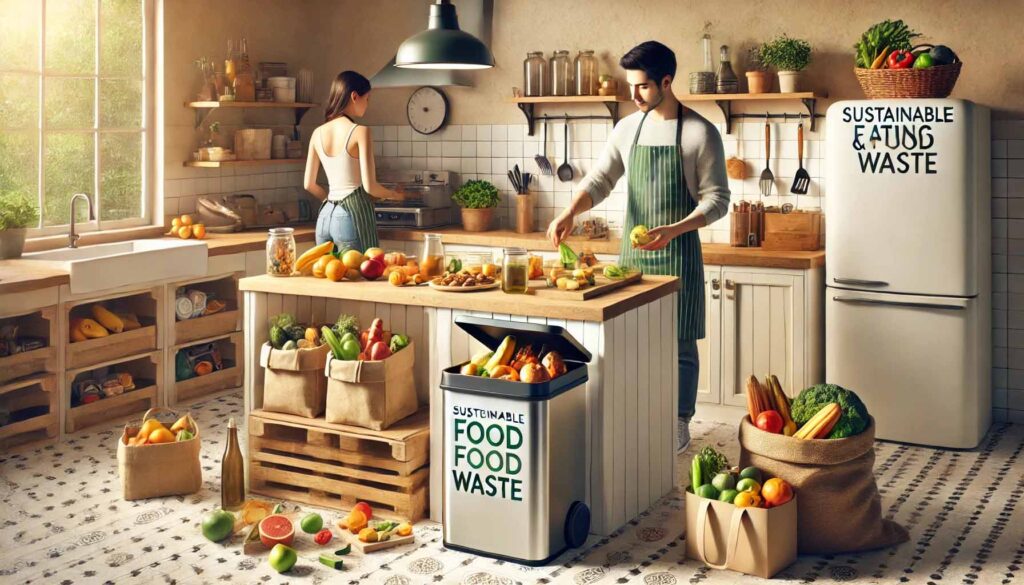Sustainable shopping is all about making choices that are better for the environment. By choosing products and brands that are eco-friendly, you can reduce your carbon footprint—the amount of carbon dioxide emissions you contribute to the atmosphere. These emissions play a big role in climate change, so taking steps to shop sustainably can make a difference. But what does it really mean to shop sustainably? Let’s break it down and explore practical ways you can start making more eco-friendly choices.

1. Choose Eco-Friendly Materials
One of the easiest ways to shop more sustainably is by selecting products made from eco-friendly materials. Many products today are made from synthetic materials, like plastic, which are bad for the environment because they take hundreds of years to decompose. Instead, look for products made from natural, biodegradable materials like:
- Organic cotton: Grown without harmful chemicals, organic cotton is a more sustainable choice than conventional cotton.
- Bamboo: Bamboo grows quickly and doesn’t require pesticides or much water, making it an eco-friendly option for products like clothing, kitchen utensils, and furniture.
- Recycled materials: Many companies now offer products made from recycled plastic, metal, or paper, helping to reduce waste.
When shopping, check labels for these materials, and try to avoid synthetic materials like polyester, which are made from petroleum-based products and contribute to pollution.
2. Buy Less, Choose Quality
A key principle of sustainable shopping is buying less overall. It can be tempting to purchase lots of inexpensive, trendy items, but these “fast fashion” products are often made cheaply and don’t last long. When you buy low-quality products that quickly wear out, you’re likely to replace them often, creating more waste.
Instead, aim to buy fewer but higher-quality items that are built to last. Whether you’re shopping for clothing, electronics, or home goods, choosing well-made, durable products means you’ll replace them less frequently, reducing both waste and your carbon footprint.
3. Shop Local
When you buy products made or grown locally, you’re helping to reduce the carbon emissions associated with shipping goods over long distances. Shipping and transportation account for a significant amount of greenhouse gas emissions, so by supporting local businesses, you’re cutting down on these emissions.
Shopping at local farmers’ markets or small businesses not only helps reduce your carbon footprint, but it also supports your community. Plus, many small businesses are more likely to use sustainable practices because they’re less focused on mass production.
4. Support Ethical and Sustainable Brands
Many brands today are becoming more transparent about their production processes and environmental impact. When shopping, look for companies that prioritize sustainability and ethical practices. Brands that are committed to reducing their carbon footprint often use renewable energy, minimize waste, and ensure fair treatment of workers.
Some certifications to look for when shopping include:
- Fair Trade: Ensures that products were made under safe working conditions and that workers were paid fairly.
- Certified B Corporation: This certification indicates that a company meets high standards of social and environmental performance.
- Global Organic Textile Standard (GOTS): For textiles, this certification means the product was made using organic materials and eco-friendly processes.
Supporting these brands encourages more companies to adopt sustainable practices, leading to broader positive change.
5. Choose Reusable Products
Single-use items, like plastic bags, straws, and water bottles, contribute to a large amount of waste. Switching to reusable alternatives can have a big impact on your carbon footprint. Consider the following reusable products:
- Reusable shopping bags: Instead of plastic bags, bring your own durable tote bags when you shop.
- Stainless steel or glass water bottles: Ditch single-use plastic bottles and invest in a reusable water bottle.
- Reusable straws: Stainless steel or silicone straws are great alternatives to plastic ones.
- Cloth napkins and towels: Reduce your paper waste by switching to reusable cloth napkins and towels for everyday use.
By making the switch to reusable items, you’ll cut down on the amount of waste you generate and help conserve natural resources.
6. Buy Secondhand
Shopping secondhand is another great way to reduce your carbon footprint. When you buy pre-owned items, you’re giving new life to something that might have otherwise ended up in a landfill. Thrift stores, online resale platforms, and garage sales are great places to find clothing, furniture, electronics, and more.
Not only does buying secondhand reduce waste, but it also helps reduce the demand for new products, which require resources to produce and transport. Plus, secondhand shopping is often more affordable than buying new.
7. Minimize Packaging Waste
When you shop, try to avoid products with excessive packaging, especially plastic packaging that’s difficult to recycle. Many companies now offer products with minimal, eco-friendly packaging made from recycled or biodegradable materials.
Here are some tips to reduce packaging waste:
- Buy in bulk: Purchasing items in bulk reduces the amount of packaging you take home. Look for bulk bins at your local grocery store where you can bring your own containers.
- Choose package-free options: Some stores offer products like produce and grains without packaging, so you can bring your own bags or jars to fill.
- Avoid single-use packaging: Try to steer clear of individually wrapped items and products packaged in plastic whenever possible.
8. Use Carbon Offset Programs
Even when we try to make sustainable choices, it’s impossible to completely eliminate our carbon footprint. That’s where carbon offset programs come in. Some companies and organizations allow you to offset the emissions created by your purchases by funding projects that reduce carbon in the atmosphere, such as planting trees or investing in renewable energy.
Some brands offer the option to purchase carbon offsets directly through their websites, or you can choose a third-party organization that provides this service. While carbon offsets aren’t a perfect solution, they can help balance out the environmental impact of your shopping habits.
Conclusion
Shopping more sustainably is a powerful way to reduce your carbon footprint and contribute to a healthier planet. By choosing eco-friendly materials, supporting ethical brands, shopping locally, and making thoughtful purchasing decisions, you can make a positive impact. Remember, even small changes in your shopping habits can add up over time, and the more people who make sustainable choices, the bigger the difference we can make together.
By focusing on sustainability, we’re not just reducing our carbon footprint—we’re also helping create a better future for the planet and future generations.
Make sure to check out more articles in our News & Views section. Feel free to reach out any time to collaborate with Food Is Health on projects which help people heal through natural food & nutrition.
Organic vs Conventional Food | Food Preservatives & Additives | Anti-Inflammatory Diets | Gut Health & Probiotics | Plant-Based Diets | Detox Diets & Cleanses | Food Allergies & Sensitivities Functional Foods | Sustainable Eating & Food Waste | Ag Related Topics | Popular Topics
